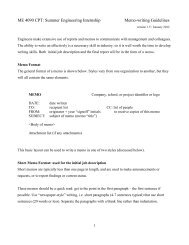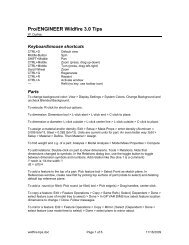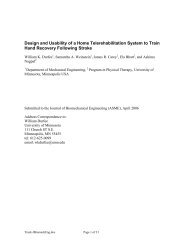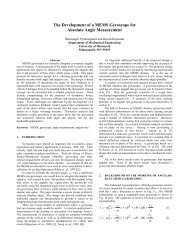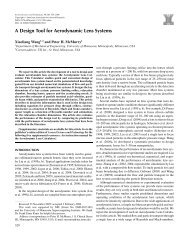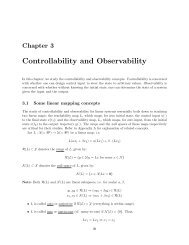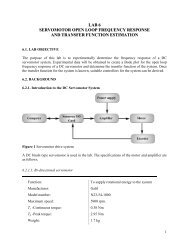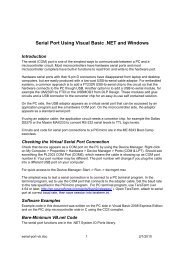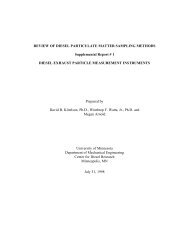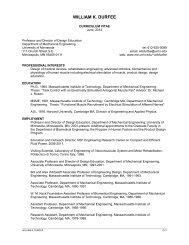Review of diesel particulate matter sampling - Department of ...
Review of diesel particulate matter sampling - Department of ...
Review of diesel particulate matter sampling - Department of ...
Create successful ePaper yourself
Turn your PDF publications into a flip-book with our unique Google optimized e-Paper software.
Volatile organic <strong>matter</strong> may remain gaseous (disregarding the use <strong>of</strong> a catalytic converter) or<br />
may undergo gas-to-particle conversion to form the SOF, the extractable fraction <strong>of</strong> DPM.<br />
As engine exhaust is diluted and cooled, SOF may move from the gas phase to the particle<br />
phase by two paths: adsorption on or absorption into existing particles or nucleation to form<br />
new particles. All <strong>of</strong> the hydrocarbons that are collected on a filter are called the SOF.<br />
Adsorption <strong>of</strong> hydrocarbons from the gas phase to existing aerosol particles will increase the<br />
size and mass <strong>of</strong> nuclei and accumulation mode <strong>diesel</strong> aerosol while decreasing the gaseous<br />
hydrocarbon concentration. Nucleation <strong>of</strong> new particles formed mostly <strong>of</strong> hydrocarbons from<br />
the gas phase will leave the accumulation mode particles unaffected, but may cause a dramatic<br />
increase in the number nanoparticles in the nuclei mode.<br />
Adsorption or Nucleation <strong>of</strong> Volatile Particle Precursors<br />
Adsorption <strong>of</strong> hydrocarbons on the surface <strong>of</strong> the carbonaceous core <strong>of</strong> <strong>diesel</strong> particles may<br />
be modeled using the Langmuir, BET, or other theories <strong>of</strong> isothermal adsorption behavior.<br />
The saturation ratio, S, is the ratio <strong>of</strong> the partial pressure <strong>of</strong> a condensable species to its local<br />
vapor pressure. For both models, increasing S (at low values <strong>of</strong> saturation ratio) causes a<br />
corresponding increase in organic adsorption to available surface area. For intermediate<br />
values <strong>of</strong> S, there is a slow increase in adsorption for increasing saturation ratio. As S<br />
approaches 1.0 adsorption gives way to condensation. Supplemental Report No. 2 (Kittelson,<br />
1998b) provides more information on the modeling <strong>of</strong> adsorption <strong>of</strong> hydrocarbons on soot<br />
particles and includes illustrations <strong>of</strong> the relation <strong>of</strong> adsorption to saturation ratio.<br />
If saturation ratios are sufficiently high, new particles may form by homogeneous nucleation<br />
<strong>of</strong> gaseous species. High saturation ratios are more likely if there is insufficient particle<br />
surface available in the exhaust for extensive adsorption. Nucleation can be responsible for<br />
the formation <strong>of</strong> nuclei-mode particles in <strong>diesel</strong> aerosol. The nuclei mode is frequently<br />
observed when <strong>diesel</strong> exhaust is rapidly diluted under either atmospheric or dilution tunnel<br />
conditions (Dolan, et al., 1975; Kittelson et al., 1988). Nuclei-mode particles consist<br />
primarily <strong>of</strong> volatile materials and will be affected by changing saturation conditions that may<br />
cause continued condensation or evaporation back into gaseous form.<br />
It has been observed in <strong>diesel</strong> exhaust that volatile organic <strong>matter</strong> can nucleate and grow to<br />
form nuclei mode particles at saturation values below supersaturation. There are<br />
heterogeneous nuclei present in <strong>diesel</strong> exhaust in the form <strong>of</strong> sulfuric acid and possibly<br />
metallic ash. It has been hypothesized that these heterogeneous nuclei are acting as the<br />
nucleation sites for the SOF and that the particles are growing by adsorption onto the metallic<br />
ash or absorption into the sulfuric acid. This would allow the growth <strong>of</strong> SOF nuclei mode<br />
particles at saturation values below 1.0. Calculations <strong>of</strong> saturation ratios associated with<br />
hydrocarbons comprising the SOF, suggest that they rarely approach 1.0, and never reach<br />
values <strong>of</strong> 3 - 4 necessary for homogeneous nucleation (Friedlander, 1977). Thus, sulfuric acid<br />
nuclei are likely precursors to the formation hydrocarbon containing nanoparticles.<br />
01/14/99 Page 18



